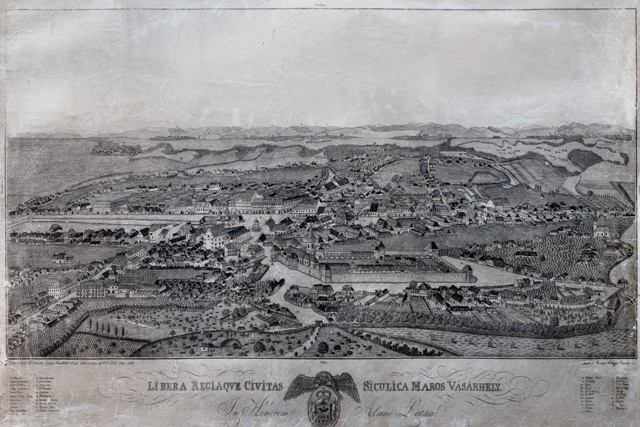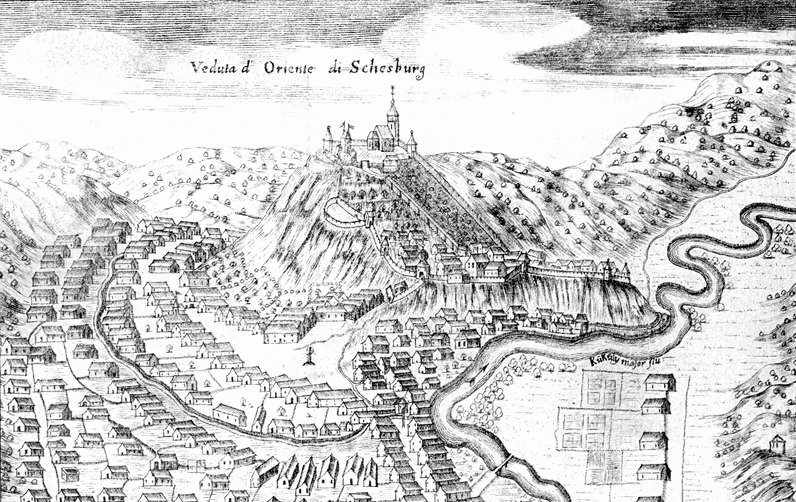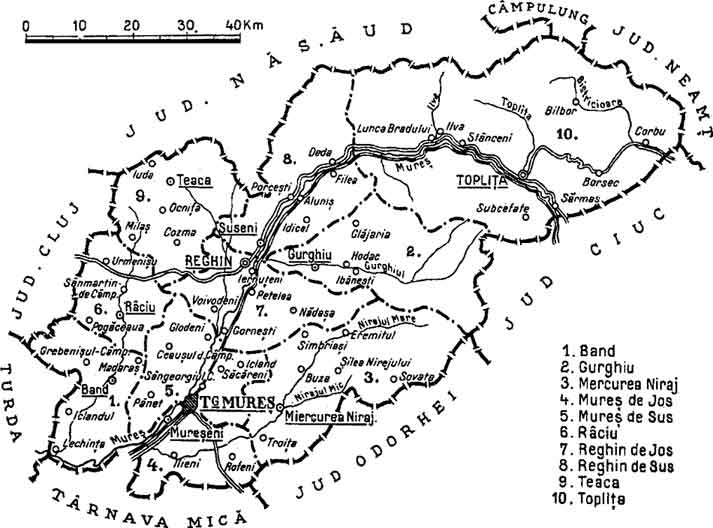  Traces
of human presence in the Mureș county date in the Neolithic Age, more precisely
the Starcevo-Criș (6000 B.C.) culture. From the Bronze Age, the most significant
discovery is connected to the Wietenberg hill, near Sighișoara, which became the
eponymic name for this archaeological culture. The end of the Bronze Epoch is
marked by the discoveries (especially the funerary ones) of the Noua culture,
of north-Pontic origin. In the 6th century B.C. the Scythian tribes make a way
into Transylvania. We find them mentioned in Herodotus' Histories, where we also
have the very first reference to the Mureș River as Maris. At the end of the 4th
century, the Celtic tribes from the Pannonian plain arrive in these territories.
From the beginning of the 2nd century B.C. we hold the first dated discoveries
concerning the Dacians. One of the most important Dacian fortifications from the
region was on the same Wietenberg hill, near Sighișoara. Starting
with the 2nd century A.D. the Superior Mureș Valley is included in the Roman Province
Dacia. Along the stream of the Mureș River and its affluents there were several
auxilia stationed in localities like: Cristești, Brâncovenești, Călugăreni, Sărățeni,
Sighișoara, etc. The Empire withdrew from this area around 270-274 A.D., event
followed shortly by the invasion of the migratory peoples, out of which the Goths
and the Gepids were the first to arrive. The presence of the former ones was initially
detected and interpreted as such in the necropolis from Sântana de Mureș, which
became the second eponymic locality from our district. The 5th century marked
the appearance of the Avars and the next one was characterised by the massive
settlement of the Slavs in Transylvania. One of the most significant settlements
was discovered at Morești. The presence of the Magyar tribes is dated at the end
of the 9th century. They took the form of a Christian kingdom at the commencement
of the 2nd millennium, in 1001, when King Stephen I was crowned.  The
emergence of the medieval kingdom had further consequences in the political-administrative
organization of Transylvania and implicitly the area nowadays belonging to the
Mureș County. In those times this region was mostly superposed by the Mureș Szeckler
Seat (the remaining parts being included in the Turda and Târvana districts) and
also the Sighișoara Saxon Seat. The evolution of the habitat in the Early Middle
Ages can only by explained with the help of the archaeological research. Important
data regarding this aspect was brought by the systematic excavations from Morești
- Sântioana de Mureș (fortification - settlement - cultic edifice). The number
and distribution of the localities can be reconstituted with the aid of the Papal
Quitrent from the beginning of the 14th century, in which most of the nowadays
localities were already mentioned. On the territory of the Mureș County, there
used to be the residence of the Szeckler comes, in the fortress of Gurghiu. As
a function, this was the most important royal dignitary, after the voivode, in
Transylvania. An important role was played by the commercial and craftsmen centres
also, of which the medieval markets later emerged. These gained more and more
privileges and autonomies from the 14th century, some of them becoming real urban
centres (like Târgu Mureș for instance). The Saxon city of Sighișoara from the
southern part of the district was an essential industrial and commercial centre,
with powerful guilds and which still preserves the medieval structures to this
day. The
emergence of the medieval kingdom had further consequences in the political-administrative
organization of Transylvania and implicitly the area nowadays belonging to the
Mureș County. In those times this region was mostly superposed by the Mureș Szeckler
Seat (the remaining parts being included in the Turda and Târvana districts) and
also the Sighișoara Saxon Seat. The evolution of the habitat in the Early Middle
Ages can only by explained with the help of the archaeological research. Important
data regarding this aspect was brought by the systematic excavations from Morești
- Sântioana de Mureș (fortification - settlement - cultic edifice). The number
and distribution of the localities can be reconstituted with the aid of the Papal
Quitrent from the beginning of the 14th century, in which most of the nowadays
localities were already mentioned. On the territory of the Mureș County, there
used to be the residence of the Szeckler comes, in the fortress of Gurghiu. As
a function, this was the most important royal dignitary, after the voivode, in
Transylvania. An important role was played by the commercial and craftsmen centres
also, of which the medieval markets later emerged. These gained more and more
privileges and autonomies from the 14th century, some of them becoming real urban
centres (like Târgu Mureș for instance). The Saxon city of Sighișoara from the
southern part of the district was an essential industrial and commercial centre,
with powerful guilds and which still preserves the medieval structures to this
day.
 Different
monastic orders were the cores of the religious and the educational life. The
significant ones were the Franciscan order from Târgu Mureș, the Dominicans from
Sighișoara and the Paulines from Sâncrai. The rich medieval history of the county
is well reflected by the multitude of the Romanic and Gothic style churches which
brought our county to the level of the western civilisation. Different
monastic orders were the cores of the religious and the educational life. The
significant ones were the Franciscan order from Târgu Mureș, the Dominicans from
Sighișoara and the Paulines from Sâncrai. The rich medieval history of the county
is well reflected by the multitude of the Romanic and Gothic style churches which
brought our county to the level of the western civilisation.
The
number of localities gradually increased in the 15th - 16th centuries. In the
time of the Transylvanian principality we distinguish the existence of names of
localities kept in their majority until today. In the same period, the structure
of the nowadays district's localities reached its definitive form. The
settlements often became the place where important historical events took place,
like the Transylvanian Diet (Parliament), which used to meet in different localities.
In spite of the conflicts with the Habsburg or the Ottoman Empires, the towns
never ceased evolving, and Târgu Mureș was granted the rank of free royal town
in 1616. The
18th and the 19th centuries passed as a period of quietness and prosperity under
the domination of the Habsburg dynasty. Several personalities of the Transylvanian
Enlightenment current led their activity in Târgu Mureș. Among the most important
ones we name: Petru Maior - historian, philologist, founding member of the Transylvanian
School and Greek-Catholic archpriest in Reghin; Aranka György - writer, founder
of the Magyar Language Society and Georg Daniel Teutsch, Lutheran bishop, representative
of the Saxon national movement, founder of the first Saxon gymnasium from Sighișoara
and also of the first German scientific magazine from Transylvania - Verein für
Siebenbürgische Landeskunde. The most important personality of our town was the
founder of the Teleki Library, Teleki Sámuel, who among other functions was also
the chancellor of Transylvania. He promoted the modernization of the public education
and was the generous sponsor of the Transylvanian cultural life. The Teleki Library
is the most important collection of the Enlightenment literature from Central
Europe. The famous mathematician Bolyai János, the inventor of the non-Euclidian
geometry used to learn and later teach at the reformed high-school from the town.
The
administrative frame of the medieval epoch was kept unaltered until the last third
of the 19th century. At the beginning of the dualist Austrian - Hungarian regime,
some modifications appeared in the administrative structure of the area. On the
territory of the present-day county there used to function a district - Mureș-Turda,
with its residence at Târgu-Mureș and several parts of counties, like Târnava
Mică (with the residence at Târnăveni), Târnava Mare (with the residence at Sighișoara),
Cluj and Turda - Arieș.  After
the First World War, at the same time with the unification of Transylvania with
the Romanian Kingdom, the notion of "Mureș County" appeared for the
first time. Its territory was smaller than the nowadays one, but it comprised
the Toplița - Borsec area, being neighboured thus by the Târnava Mică, Turda,
Cluj, Năsăud, Neamț, Ciuc and Odorhei Counties. After
the First World War, at the same time with the unification of Transylvania with
the Romanian Kingdom, the notion of "Mureș County" appeared for the
first time. Its territory was smaller than the nowadays one, but it comprised
the Toplița - Borsec area, being neighboured thus by the Târnava Mică, Turda,
Cluj, Năsăud, Neamț, Ciuc and Odorhei Counties.
The
installation of the communist system had as one of the consequences the application
of the Soviet administration model in Romania. In 1950, the Mureș Region was created,
comprising the previous territory of the Mureș County, to which the Gheorgheni,
Ciuc and Odorhei districts were attached. In 1952, following Soviet directions,
the system suffered from a new organizational reform, which led to the formation
of the Autonomous Magyar Region, with the residence at Târgu Mureș. It consisted
of the previous Mureș Region, and also the Sfântu Gheorghe and Târgu Secuiesc
districts. It coincided more or less with the Szeckler Region, and the majority
of the population (77%) was made up of Magyars, who had important cultural autonomy
(for instance, the Magyar language was official language). The situation was modified
in 1960, when the Mureș - Autonomous Region was born; it also contained the Luduș
and Târnăveni (parts of the Cluj Region) districts. In
1968, the Government of Romania restored the old administrative system (commune-county),
giving up to the Soviet model. It was in the same year that the limits of the
today Mureș County were established. The residence was the same, at Târgu Mureș,
and apart from the town of Sighișoara, other towns of the county were Reghin,
Târnăveni, Luduș, Sovata and later Iernut. After
the communist organization fell, the towns Reghin and Târnăveni were raised to
the municipal rank. Many more localities became towns after 2000 (Deda, Sângeorgiu
de Pădure, Miercurea Nirajului, Sărmașu and Ungheni). Today, our county has 91
communes and 460 villages. Written
by museum experts: Berecki Sándor, Crișan Coralia, Györfi Zalán, Rus Dorin. |

